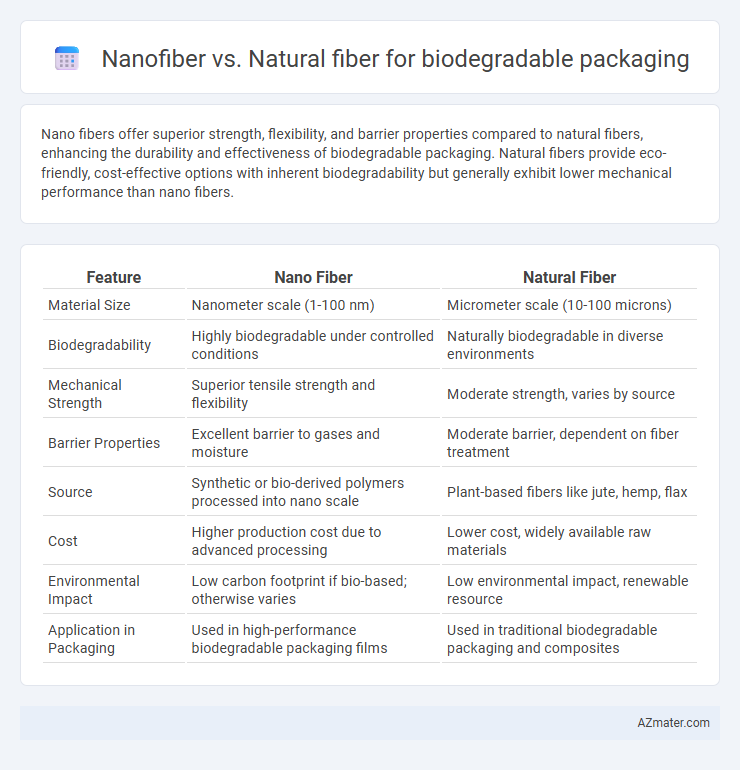Nano fibers offer superior strength, flexibility, and barrier properties compared to natural fibers, enhancing the durability and effectiveness of biodegradable packaging. Natural fibers provide eco-friendly, cost-effective options with inherent biodegradability but generally exhibit lower mechanical performance than nano fibers.
Table of Comparison
| Feature | Nano Fiber | Natural Fiber |
|---|---|---|
| Material Size | Nanometer scale (1-100 nm) | Micrometer scale (10-100 microns) |
| Biodegradability | Highly biodegradable under controlled conditions | Naturally biodegradable in diverse environments |
| Mechanical Strength | Superior tensile strength and flexibility | Moderate strength, varies by source |
| Barrier Properties | Excellent barrier to gases and moisture | Moderate barrier, dependent on fiber treatment |
| Source | Synthetic or bio-derived polymers processed into nano scale | Plant-based fibers like jute, hemp, flax |
| Cost | Higher production cost due to advanced processing | Lower cost, widely available raw materials |
| Environmental Impact | Low carbon footprint if bio-based; otherwise varies | Low environmental impact, renewable resource |
| Application in Packaging | Used in high-performance biodegradable packaging films | Used in traditional biodegradable packaging and composites |
Introduction to Biodegradable Packaging
Biodegradable packaging utilizes materials that decompose naturally, reducing environmental impact compared to conventional plastics. Nanofibers, with their high surface area and enhanced mechanical properties, offer superior barrier performance and durability for packaging applications. Natural fibers, derived from renewable sources like cellulose or hemp, provide eco-friendly biodegradability but often require reinforcement to match the strength and functionality of nanofiber-based materials.
Overview of Nano Fibers
Nano fibers exhibit exceptional properties including high surface area-to-volume ratio, enhanced mechanical strength, and superior barrier performance, making them ideal for biodegradable packaging applications. These fibers, typically derived from cellulose or synthetic polymers at the nanoscale, improve packaging durability while maintaining eco-friendliness by accelerating compostability and reducing environmental impact. Their nanoscale dimensions enable effective protection against moisture, oxygen, and microbial contamination, extending shelf life without compromising biodegradability.
Overview of Natural Fibers
Natural fibers, derived from plants such as jute, hemp, and flax, offer renewable and biodegradable properties ideal for sustainable packaging solutions. Their inherent strength, biodegradability, and low environmental impact make them favorable for eco-friendly packaging compared to synthetic alternatives. The cellulose content and microfibrillar structure of natural fibers contribute to durability and compatibility with biodegradable composites in packaging applications.
Material Properties: Nano Fibers vs Natural Fibers
Nano fibers exhibit exceptional tensile strength, high surface area, and controlled porosity, enhancing barrier properties critical for biodegradable packaging. Natural fibers offer renewable, biodegradable benefits with good mechanical strength but often lack uniformity and lower barrier efficiency compared to nano fibers. The nanoscale dimensions of nano fibers improve moisture resistance and gas permeability, making them superior in extending shelf life and performance in eco-friendly packaging applications.
Environmental Impact and Biodegradability
Nano fibers exhibit superior biodegradability and lower environmental impact compared to traditional natural fibers due to their higher surface area and ability to break down faster in composting environments. Natural fibers, while biodegradable, often degrade slower and can leave behind residues or require more resources for cultivation, affecting overall sustainability. Utilizing nano fibers in biodegradable packaging enhances material efficiency and reduces landfill accumulation, supporting eco-friendly waste management practices.
Mechanical Strength and Durability Comparison
Nanofibers exhibit superior mechanical strength and enhanced durability compared to natural fibers, making them highly effective for biodegradable packaging applications. Their nanoscale dimensions provide a high surface area-to-volume ratio, resulting in improved tensile strength and resistance to wear under various environmental conditions. Natural fibers, while biodegradable and renewable, often show variability in strength and faster degradation rates, limiting their long-term durability in packaging uses.
Barrier Properties in Packaging Applications
Nanofibers exhibit superior barrier properties compared to natural fibers due to their extremely fine diameter and high surface area, which significantly reduce gas and moisture permeability in biodegradable packaging. Natural fibers, while renewable and biodegradable, often possess larger pore sizes and lower density, resulting in less effective moisture and oxygen barriers. Enhancing packaging applications with nanofiber layers improves product shelf life and protection by creating more efficient barriers against external environmental factors.
Cost Efficiency and Scalability
Nano fibers offer enhanced mechanical strength and barrier properties at a higher production cost compared to natural fibers, which are more cost-effective and widely available. Natural fibers, derived from renewable sources like hemp and jute, enable scalable manufacturing using existing agricultural and industrial infrastructure. The balance between nano fiber technology's superior performance and natural fibers' affordability determines optimal biodegradable packaging solutions for large-scale commercial applications.
Safety and Regulatory Considerations
Nanofibers used in biodegradable packaging often undergo rigorous safety assessments to ensure they meet regulatory standards such as FDA or EFSA approvals, addressing concerns about nanoparticle migration and potential toxicity. Natural fibers, derived from cellulose, hemp, or jute, generally pose fewer safety risks due to their established biodegradability and non-toxic nature but still require compliance with food contact material regulations. Both materials demand thorough evaluation for allergens, microbial contamination, and environmental impact to ensure consumer safety and adherence to global packaging regulations.
Future Trends in Biodegradable Packaging Materials
Nano fibers exhibit superior mechanical strength, high surface area, and enhanced barrier properties, positioning them as a key material in the future of biodegradable packaging. Natural fibers, derived from renewable resources such as hemp, jute, and flax, offer environmental benefits and biodegradability but often lack consistency in performance compared to nano-engineered materials. Advances in nanotechnology and green chemistry are expected to drive the development of hybrid packaging solutions that combine the sustainability of natural fibers with the functional advantages of nano fibers for improved biodegradability and durability.

Infographic: Nano fiber vs Natural fiber for Biodegradable packaging
 azmater.com
azmater.com